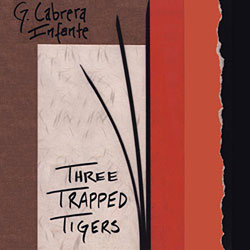|
In
the middle
of a
convoluted
discussion
found in
Guillermo
Cabrera
Infante’s
comic novel Three Trapped Tigers (Tres Tristes Tigres)
about the
continuum of
life and
death that
begins its
twisting
roll with
such
references
to strong
men and
passwords
comes a nod
toward
Gertrude
Stein as Get tru Stem:
&
Death is a
return to
the point of
departure, a
completing
of the
circle, a
way back to
a total
future. In
other words,
to the past,
to the past
as well. In
other words,
to eternity.
If you like
you can add
something
from T. S.
Eliot (Or
Tess Elihoo,
as he
pronounced
it), like
Time present
and time
past or that
quotation
from
Gertrude
Stein you
are so fond
of. (Did I
tell you it
sounded like
Get tru
Stem?)

Before taking another step, Dear One on the other side of this page, as
Cabrera Infante would address you, let the Steiny Road Poet interrupt to
explain that this overly stuffed novel, with a running vignette of a woman
talking to her shrink, has four main characters. These men—the
photographer C贸dac, the actor Arsenio Cu茅, the percussionist Erib贸, and
the writer Silvestre—are the trapped (or sad, depending on which
language your reading copy is in) tigers. Thus, like Alexandre Dumas’
novel The Three Musketeers where there are four musketeers, we find four
artists filling the roles of Three Trapped Tigers.
Steiny probably has missed some other reference to the Mama of Dada that
might clear up which quotation by Stein the Cuban author Cabrera Infante
might be gesturing toward. This nearly 500-page novel in Spanish set in
Havana just prior to its revolution was published in 1965 and translated
into English by Donald Gardner and Suzanne Jill Levine in 1971. The
writing style with its highly evolved word play evokes Stein’s nemesis
James Joyce and the Joy(ce) ride accomplished in Ulysses.

Could the Stein quote be the one everyone uses today with impunity:
“There is no there there.” Steiny says impunity because most people who
quote Stein do not know these words are hers. When, in 1935, Stein hired a
car in Southern California to visit the Oakland home in which she spent
most of her childhood, she discovered the place had been torn down. Ergo,
there was no there there.
Of course, Death (capital D as a location in the cycle of Life) has no
substantive locus be it Heaven or Hell. Cabrera Infante says Death is a
“point of departure” that completes a circle leading to a “total future.”
Stein, as philosophy student of William James often incorporated circles
and circular arguments into her oeuvre. As in Stein’s work, substantial
meaning can be found in Cabrera Infante’s repetitions. For example: “In
other words, to the past, to the past as well”, it would be easy to let this go
with the understanding that “as well” just means “also.” However, “well”
could mean a hole of water or, metaphorically, a deep source of creativity. Three Trapped Tigers is a veritable speakeasy rife with such passwords
that open realms of intellectual intoxication.
If, Dear Reader, you move from the microscopic to macro view of this
novel of voices, much of Three Trapped Tigers claims a source in Gertrude
Stein—her always experimenting theater, her cubist points of view, her
retelling of the same tale, her contrarian twists, her gaming, her play with
numbers, her poetic language, her deconstruction of words that become
elemental letters. What Cabrera Infante primarily does differently from
Stein is fill his novel with in-your-face literary allusions and mentions of
historic and popular events. Notice that he starts with an epigraph from
Lewis Carroll’s Alice in Wonderland: “…And she tried to fancy what the
flame of a candle looks like after the candle is blown out.” What this
epigraph points to is the author’s intention to evoke the old Havana of
nightclubs and endless parties of sex, drugs, and excesses, but more so, the
people who lived in that milieu.
Whatever the “tru Stem” or scaffolding of Guillermo Cabrera Infante’s Three Trapped Tigers is, today’s astute reader of Cabrera Infante’s through
-the-looking-glass treatise might see a current day connection between
Cuba and the United States of America. Initially, there were Cubans of all
financial circumstances who fell in love with Fidel Castro who promised a
Utopia for this island nation—a Utopia built on a Soviet Communism, a
Utopia which would cleanup the decadence of old Havana and ensure
everyone was taken care of. What they have today is poverty and food
shortages accented by an undying love of old American cars that they
maintain without standard parts from the Mainland. Today in the U.S.A.,
most Republicans have an unbreakable addiction to Donald J. Trump who
has perfected the delivery of crazy talk mixed with a frightening screed of
praise for Putin, the bellicose leader of the communist world, and a
promise to dismantle the U.S. justice system and its social programs that
help with healthcare and financial wellbeing. One last thing, the password
for this uncertain time on Earth is power with absolutely no sharing—so
much for a comic novel.
|